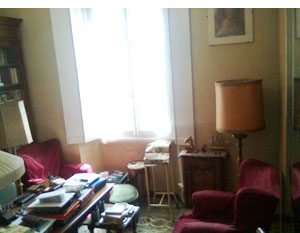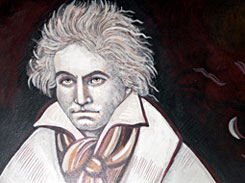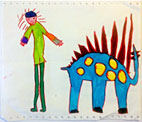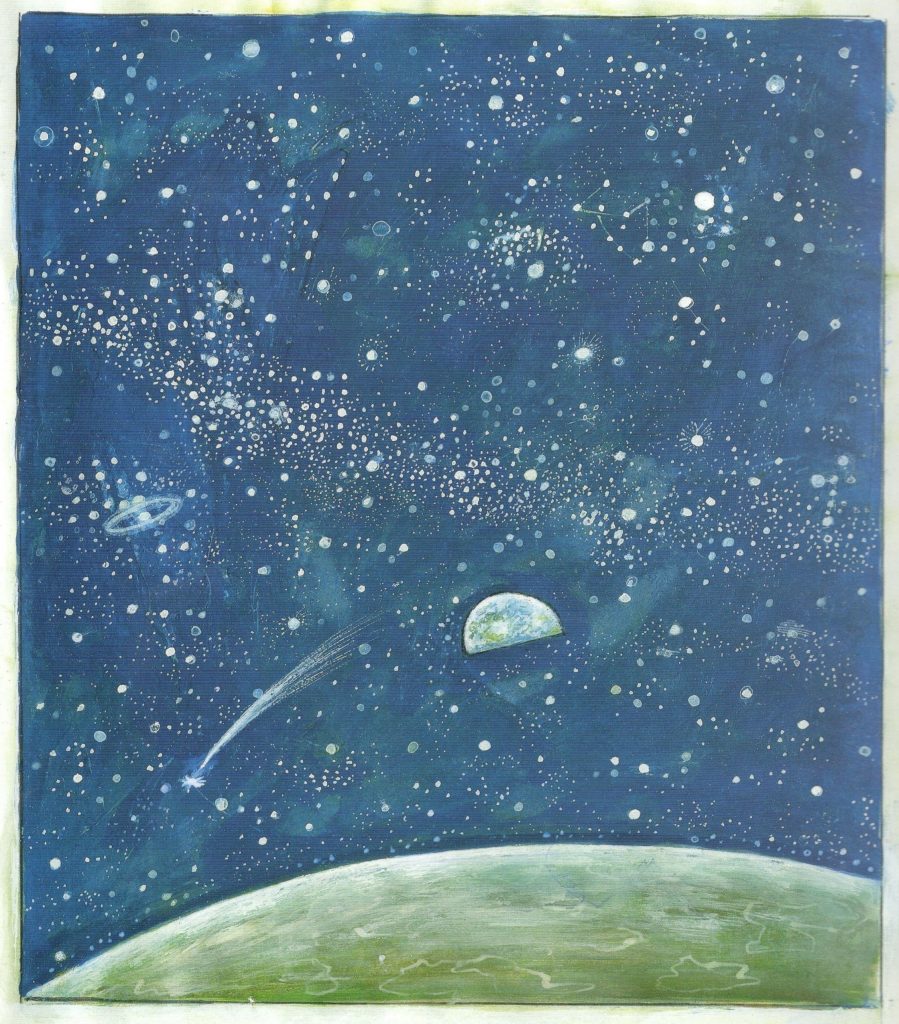Setting: both a concrete and a metaphorical space

The classical image of Freudian analysis revolves around the couch used by the patient, and the analyst’s chair located behind the couch. The room is barren so as not to influence the patient’s fantasies. In the Jungian tradition, two armchairs, one in front of the other, are used. In this way, the analyst and the patient can communicate face to face, and the emotional reactions of each person can be perceived by the other. In setting up one’s consulting room, some analysts remain concretely faithful to this somewhat rigid arrangement. In my opinion, the analytical setting should be seen as a metaphorical reality which can change and take form on the basis of the analyst’s personality.
Anyone who has been to see Freud’s consulting room in Vienna or Jung’s study in Küsnacht will immediately notice how different the arran\gement rigidly prescribed by future students and followers is from the way these two pioneers of psychoanalysis actually worked. In a room adjoining his consulting room, Freud’s wife prepared tea and biscuits that were served to patients. From Jung’s consulting room, through the shelves filled with books and the stained glass windows, one could catch a glimpse of the lake; one could also hear the voice of his mother singing a lullaby to one of her grandchildren. These situations, documented by the testimony of eye witnesses, are all richly warm with feeling.
I myself am a doctor and a Jungian analyst, and for some years now I have dedicated a great deal of time to psychological work with children.
As far as I am concerned, the term “clinical” means “therapeutic”: a whole series of factors which offer care in the widest sense of the word and which can lead to a transformation of the initial problems displayed by the patient, resulting in a re-structuring of ego consciousness. My analytical space was enlarged with the introduction of the therapeutic technique known as “Sandplay therapy”, invented and developed by Dora Kalff. I feel I cannot be identified with either adult analysis, Sandplay therapy or child therapy. My work takes form and is carried out according to the needs of each single patient.
In the sandtray, “one’s hands know what the mind doesn’t know”

Sandplay therapy cannot really be understood by anyone who has not had practical personal experience of it. Contact with sand seems to have an almost magical quality, transmitting age old energies. Nearly all patients plunge their hands into this sand which is mother earth, material and transcendent at one and the same time. They tend to caress it for a long time as if they were caressing their own bodies or the body of another person. One young patient of mine who always wanted to play basketball always wanted to plunge the ball into the sandtray before starting to play so that it could absorb some of the tray’s energy.
Naturally every therapist, while maintaining the basic arrangement of the sandtray and the shelves containing the small figurines used in the scenes, is free to choose those figurines which correspond to his or her sensitivity and which he or she feels will best help the patients using this method. In this way, a transference and counter-transference relationship between therapist and patient is already present and operative in the arrangement of the materials used in building the sand scenes.
Within the “free and protected space” of the sandtray, what the patient creates may be stimulated by some personal experience or by an emotional state which he or she wants to express.
At times this stimulus may be aroused by the sight of an external object to which, like a sort of echo, an unconscious perception responds. The response may also take the shape of an emotion which had been lying in the unconscious creating a form of suffering or of happiness which could not be reached simply using words. Thus we often say that “one’s hands know what the mind doesn’t know.” Often these perceptions go all the way back to the very first days of the primary relation with the mother; at this point an Ego that can be distinguished from a non-Ego has not as yet taken shape.
 During the therapeutic process of sandplay, every patient lives his or her personal descent into the underworld; down there, there may be battles with monsters in order to free the imprisoned treasure which is in each of us but is held captive by a Siren-soul which has not as yet been humanized. And yet, here the light of the stars or the “lumen naturae” of the alchemists already shines. The therapist must be able to create within himself or herself that empty space which will allow him or her to welcome what the patient is objectifying in the sandtray and to respectfully follow, though his or her attention and understanding, the distant situation which is emerging from the patient’s unconscious.
During the therapeutic process of sandplay, every patient lives his or her personal descent into the underworld; down there, there may be battles with monsters in order to free the imprisoned treasure which is in each of us but is held captive by a Siren-soul which has not as yet been humanized. And yet, here the light of the stars or the “lumen naturae” of the alchemists already shines. The therapist must be able to create within himself or herself that empty space which will allow him or her to welcome what the patient is objectifying in the sandtray and to respectfully follow, though his or her attention and understanding, the distant situation which is emerging from the patient’s unconscious.
A profound transference and counter-transference relationship

The sort of comprehension we have in our work should be a real “cum-prendere”, a way of welcoming or taking into oneself the contents that emerge in therapy. It is important for the analyst to know the actual objective situation a patient has lived through or is living at that time, but a good therapist must also be able to grasp the inexpressible reality which the patient is attempting to express symbolically through the choice of the objects to utilize, the words which accompany his or her work in the sandtray, the way he or she speaks to the objects, through the moments of silence and the tears that are shed, the way the patient sings or whistles during the work.
A deep transference-countertransference relationship is, in any case, fundamental. This relationship will give birth to the sense of collaboration and to the seriousness of this form of play; what is created is a sort of “middle realm” in which fantasy can take form. It is a transitional space between the world of inner images and external reality. In this way the patient will be able to come out of the narrow twists and turns of his or her ego centered situation and be open to the experience of those archetypal contents which are the potential forces of transformation lying in the unconscious. Often a patient who has elaborated his or her personal process through sandplay, will subsequently turn to active imagination.
In sessions with adults, the atmosphere is always changing
 During my many years of work in this field, I have noticed time and time again how the atmosphere in the metaphorical analytical room is in a state of constant change. Analytical sessions with adults generally begin with the patient’s narration of what has happened in his or her life. One then proceeds to the analysis of dreams – a precious resource which show us the path to follow as well as the dangers, the shadows and the new perspective that are opening up. Not every patient, however, brings a dream to every session.
During my many years of work in this field, I have noticed time and time again how the atmosphere in the metaphorical analytical room is in a state of constant change. Analytical sessions with adults generally begin with the patient’s narration of what has happened in his or her life. One then proceeds to the analysis of dreams – a precious resource which show us the path to follow as well as the dangers, the shadows and the new perspective that are opening up. Not every patient, however, brings a dream to every session.
On various occasions I have given voice to a patient’s difficult emotional state by reading a poem or recounting a fairy tale or a myth, or by listening to music together. I remember a patient who seemed to be a classic example of “spiritual death” with little if any hope of any sort of rebirth. But by listening together to the “adagio” (“the death of the hero”) of Beethoven’s Third Symphony, something important started to move and take form. Following the terrible atmosphere of cosmic death expressed by this part of the symphony, there is the “scherzo” of the third movement and finally the triumphant rebirth expressed by the fourth movement.
There aren’t words to express the powerful emotions that the patient and I experienced during this session. At times patients break down into desperate fits of crying only to move into moments of refreshing silence. In various situations in which a patient suffered from severe melancholy or from a form of heartache that seemed to blot out any hope of healing, I have had the patient lie down on the couch, covered him or her with a warm woolen blanket, and gently caressed him or her. But at other times, in the face of attempts at manipulation or in the wake of types of behavior which were lacking in respect, I have been moved to jump up and severely scold the patient for acting in such a way.
With children, play is the most important thing
 They don’t speak about the family problems or about what happens at school – they simply play! And through their play they express what they have to say. It is fundamental for the therapist to actively participate in a child’s play activity. When children play in the sandtray, they demand that the therapist pay close, constant attention to what they are doing. The therapy room becomes a venue for a wide variety of fantasies and for extremely active forms of play. Card games, sharpshooting and archery, table tennis and mini-football, car races and games of hide and seek, drawings or the designing and producing of clothes for dolls, modeling with clay, cooking, eating together – there is no end to the kinds of activities that emerge during the therapy, and the respective roles of the therapist and the little patient are exchanged back and forth in continuation.
They don’t speak about the family problems or about what happens at school – they simply play! And through their play they express what they have to say. It is fundamental for the therapist to actively participate in a child’s play activity. When children play in the sandtray, they demand that the therapist pay close, constant attention to what they are doing. The therapy room becomes a venue for a wide variety of fantasies and for extremely active forms of play. Card games, sharpshooting and archery, table tennis and mini-football, car races and games of hide and seek, drawings or the designing and producing of clothes for dolls, modeling with clay, cooking, eating together – there is no end to the kinds of activities that emerge during the therapy, and the respective roles of the therapist and the little patient are exchanged back and forth in continuation.
The therapist, taking care not to lose his or her own centering, must genuinely thrown himself or herself into the games; our position becomes that of a person who has “one foot in and one foot out”, as our esteemed teacher Mariella Loriga, whose teachings echo the teachings contained in the books of Dora Kalff, used to repeat.
If an analyst is truly Jungian, his or her room will be warm and welcoming
 Pirandello’s Qui si recita a soggetto is a sort of rule of thumb to be applied in the therapy room where new characters in search of an author are continually emerging. After so many years of work, the lives of the patients who have worked with me analytically flow past my eyes. The trials and tribulations of life need to be faced up to again and again, as I hear them narrated by young therapists who come for supervision sessions, either individually or in groups. At times the reality of life seems far more bizarre than any fantasy, and yet no matter how serious a situation may be, the accompanying fantasies produced by the unconscious are an indispensible aid in overcoming truly catastrophic situations. Every analyst has his or her own personal way of dealing with the various types of pathology he or she encounters. If an anlyst is truly Jungian and lives the true spirit of Jung, he or she will be deeply touched by the principle of Eros as well as possessing a solid scientific understanding of the psyche. The analytical space will be warm and welcoming. What can be felt in an atmosphere like this is the honest spirit of research which is so evident in all of the teachings of Carl Gustav Jung. Those who follow in his footsteps without abandoning a critical spirit, will have that same sort of honest searching spirit which is so necessary is we want to help those who knock at our doors.
Pirandello’s Qui si recita a soggetto is a sort of rule of thumb to be applied in the therapy room where new characters in search of an author are continually emerging. After so many years of work, the lives of the patients who have worked with me analytically flow past my eyes. The trials and tribulations of life need to be faced up to again and again, as I hear them narrated by young therapists who come for supervision sessions, either individually or in groups. At times the reality of life seems far more bizarre than any fantasy, and yet no matter how serious a situation may be, the accompanying fantasies produced by the unconscious are an indispensible aid in overcoming truly catastrophic situations. Every analyst has his or her own personal way of dealing with the various types of pathology he or she encounters. If an anlyst is truly Jungian and lives the true spirit of Jung, he or she will be deeply touched by the principle of Eros as well as possessing a solid scientific understanding of the psyche. The analytical space will be warm and welcoming. What can be felt in an atmosphere like this is the honest spirit of research which is so evident in all of the teachings of Carl Gustav Jung. Those who follow in his footsteps without abandoning a critical spirit, will have that same sort of honest searching spirit which is so necessary is we want to help those who knock at our doors.
Ricavato da “Riflessioni ed esperienze”, contributo di Adriana Mazzarella in Maria Irmgard Wuehl (a cura di), Nella stanza dell’analista junghiano. Stili e metodi di lavoro analitico a confronto, Biblioteca di Vivarium, Milano 2002.

